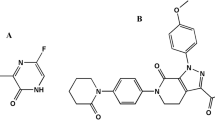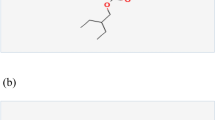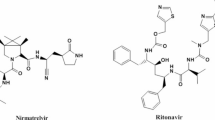Abstract
We hereby introduce a sensitive fast straightforward spectrofluorometric method for the estimation of remdesivir and favipiravir. The two drugs are prescribed in some regimens to treat COVID‐19 pandemic disease, which is caused by SARS‐CoV‐2. The method is based on the first derivative synchronous spectrofluorimetry approach for the measurement of remdesivir and favipiravir. This was accomplished at 251 nm and 335 nm respectively using the first derivative order at delta lambda of 140 nm. A linear response with a correlation coefficient 0.9994 was achieved between the concentration and the derivative amplitudes in the ranges of 20.0–100.0 ng ml−1 and 40.0–100.0 ng ml−1 for remdesivir and favipiravir, respectively. The methods were validated for different parameters as stated by the pharmacopeial rules and were applied successfully for estimation of the studied drugs in their synthetic mixtures and in spiked human plasma samples. No significant difference was observed between the proposed and comparison methods as revealed from the analysis of data.
Similar content being viewed by others
Introduction
COVID-19 is a disease that has made severe disturbance to humanity across the world. This disease initiated by SARS‐CoV‐2 is a single‐stranded RNA virus that has high transmission rate and infectivity compared to other viruses. Researchers focused on the treatment development and controlling measures against coronavirus. Different antiviral therapies have exhibited satisfying results from which, remdesivir and favipiravir are two such drugs. It was found that these drugs inhibit viral enzyme RNA-dependent polymerase and thereby have therapeutic potential in the treatment of COVID-19 [1].
Remdesivir (RMD), as in Fig. 1A: is 2-ethylbutyl (2S)-2-[[[(2R,3S,4R,5R)-5-(4-aminopyrrolo[2,1-f][1,2,4]triazin-7-yl)-5-cyano-3,4-dihydroxyoxolan-2-yl]methoxy-phenoxyphosphoryl]amino]propanoate [2]. It inhibits the viral RNA-dependent, RNA polymerase with in vitro inhibitory activity against SARS-CoV-1 [3]. It is observed that treatment with RMD may prevent the progression to more severe respiratory disease [4].
Favipiravir (FVP), as in Fig. 1B; is 5-fluoro-2-oxo-1H-pyrazine-3-carboxamide [5]. It is a purine nucleic acid analog and one of the drugs that are indicated for the treatment of patients with mild to moderate COVID-19 disease [6]. It is a pyrazine carboxamide derivative, having antiviral activity against a number of RNA viruses [7]. FVP was first introduced by Toyama Japanese Company. Later, it was permitted in Japan for influenza treatment [8, 9].
Several trials have been started to assess the safety and efficiency of RMD and FVP in COVID‐19 patients [10, 11]. Latest findings recommend RMD and FPV as antiviral agents for short term combating of COVID‐19 [6].
The literature discusses various methods for the determination of the two antiviral drugs RMD and FVP either separately or with other drugs including spectroscopy [12, 13], HPLC [12,13,14,15,16,17,18], electrochemistry [19, 20], spectrofluorimetry [18, 21] and capillary electrophoresis [22]. A review that covers most of the analytical methods developed for the quantitative determination of RMD in biological matrices is recently published [23]. In the previous reported methods; the low sensitivity of spectrophotometric methods was an obvious disadvantage [12, 13]. From the economic and environmental aspects, liquid chromatography is not favored because of extensive volumes of highly pure organic solvents and tedious sample preparation procedures. Additionally, HPLC approach is often very costly, and this expense can be prohibitive for clinical laboratories. As a result, we aimed to provide another cost effective alternative. Till present, no spectrofluorometric method was yet reported for the concurrent determination of RMD and FVP together although the two drugs are reported to exhibit native fluorescence [18, 21].
In this study, a new method is proposed for the simultaneous estimation of the two antiviral remedies at the nanogram level. The accessibility of the spectrofluorometric technique is beneficial in quality control analyses and in laboratories that lack costive or complicated operating systems. This work describes the application of the new methodology for the quantification of the binary mixture of RMD and FVP in different laboratory-prepared mixtures without prior separation. Moreover, the ease and sensitivity of the method allow quantitative measuring of the drug in samples of human plasma.
Experimental
-
Instrumentation, chemicals and materials
All the measurements were recorded using Cary Eclipse fluorescence spectrophotometer (Agilent Technologies), equipped with a xenon lamp and the spectra were smoothed with a factor of 20. The data were manipulated by Cary Eclipse software to calculate the first order of the synchronous spectra of the drugs. Data were obtained using delta lambda of 140 nm at 251 nm and 335 nm for RMD and FVP, respectively.
Samples of pure RMD and FVP were kindly donated by EIPICo, Egypt. Solvents (HPLC grade) were bought from Sigma‐Aldrich (Germany). Chemicals for the preparation of different buffers were purchased from El‐Nasr Pharmaceutical Chemicals Co., Egypt. Analytical grade chemicals were used throughout the work.
Human plasma samples were obtained from the Egyptian National Blood Bank, Mansoura, Egypt, and kept frozen at -20 °C until use, then gentle thawing is performed.
Sample Preparation
-
Preparation of standard and working solutions:
A 100.0 μg/mL standard ethanolic solution of RMD and FVP were prepared in separate 100 mL volumetric flasks by dissolving 10 mg of each drug in ethanol. Then we completed the volume to the mark with the same solvent. Working standard solutions were then prepared by subsequent dilution with ethanol.
-
Preparation of biological samples:
Plasma samples were kept at kept frozen at -20 °C, then subjected to gentle thawing before use. 1 mL from the samples were transferred in centrifugation tubes to procced in the method development.
Method Development and Applications
-
1.
For calibration curves; different concentrations from both RMD and FVP working solutions in the range of 20.0–100.0 ng mL−1 and 40.0–100.0 ng mL−1, respectively were transferred into 10-mL volumetric flasks and completed with ethanol. Each drug was measured separately using synchronous fluorometry at Δλ = 140 nm, then the spectra were converted to the first derivative order using Cary Eclipse software. Finally, RMD and FVP were measured at 251 nm and 335 nm respectively to construct calibration curves. The corresponding regression equations were then derived.
-
2.
For investigation of synthetic mixtures of both drugs; different concentrations were prepared together in 10-mL measuring flasks in ethanol to reach the following concentrations: (100.0,30.0), (50.0,50.0), (40.0,80.0), (30.0,100.0) ng mL−1. The same procedure for calibration curves was followed to calculate percentage recoveries.
-
3.
For spiked plasma samples, aliquots (1.0 mL) of plasma samples were transferred into centrifugation tubes. The samples were spiked with different concentrations of each drug in ascending manner to locate the final concentrations within the linear range (20.0–100.0 ng mL−1 and 40.0–100.0 ng mL−1) for RMD and FVP, respectively. These tubes were mixed well, and acetonitrile was added. The final volume was adjusted to be 5.0 mL. Samples were vortex mixed for 3 min, then centrifuged at 3000 rpm for 30 min. 1.0 mL aliquots of the upper layers were quantitatively transferred into another set of 10 mL volumetric flasks and a blank experiment was carried out concurrently. The general procedures described for the calibration curves were followed. Specific calibration curves were constructed for each drug and mixtures of two drugs were also investigated inside the biological matrix.
Results and Discussion
Fluorescence is the emission of light from any substance and occurs from electronically excited states. Overlapping spectrum is a common problem in resolving more than one drug (Fig. 2). The satisfactory resolution of mixtures always can be performed by synchronous spectrofluorimetry [24]. It is also called Stokes shift emission spectroscopy [25]. In such technique, the signal is recorded by simultaneously scanning the excitation and emission wavelengths at the same speed with a fixed wavelength (Δλ) between the excitation and emission wavelengths. This method uses an inexpensive solvent, and relatively the utilized instrument is commonly available in most quality control laboratories. In our study, minor overlap still occurs in synchronous spectrofluorimetry as illustrated in Fig. 3. Therefore, we aimed to estimate RMD and FVP simultaneously based on a sensitive first derivative synchronous method to remove any interference and increase the selectivity of the method (Fig. 4).
The parameters associated with the sensitivity, repeatability, and accuracy of the method were evaluated individually including solvent, pH, surfactants, and Δλ.
Solvents may have a significant effect in synchronous fluorometry, as they may influence resolution of spectra, blank and sensitivity. Water, ethanol, methanol, and acetonitrile were tried. Water resulted in the highest sensitivity; however, it affects resolution of RMD and FVP. Hence, ethanol was chosen in this study to compromise separation and sensitivity as shown in Fig. 5.
Different pH values were investigated using different buffers, as illustrated in Fig. 5 using Britton Robinson and borate buffers from 3.6 to 8. The optimum condition was attained using ethanol only without adding any buffer.
Surfactants were studied to reach maximum sensitivity using micellar media above critical micelle concentration. Anionic surfactant (SDS), nonionic surfactant (Tween-80) and (cremophor RH-40), cationic surfactant (cetrimide) were tried using 1 mL of each surfactant (1.0% w/v). No significant enhancement was achieved using any of these surfactants.
The selection of optimum Δ λ is an important factor as it could significantly affect the resolution, sensitivity and spectra symmetry. Thus, variable Δ λ values (20–160 nm) was carefully investigated. Δ λ of 140 nm revealed the best band shapes with the highest sensitivity for both drugs.
Validation Parameters
Under the optimized conditions, a linear response was obtained between the first derivative amplitudes and the concentrations for each of RMD and FVP over the ranges of 20.0–100.0 ng ml−1 and 40.0–100.0 ng ml−1, respectively with the following regression equations:
where Y is the first derivative amplitude and X is the corresponding concentration.
Limits of quantitation and detection were computed mathematically following ICH guidelines [26]. LOQ values were found to be 8.57, 10.79 ng/ mL and LOD were 2.83, 3.62 ng/mL for RMD and FVP respectively. Table 1 summarizes the validation data for the designated methodology.
Accuracy has been determined by calculating mean percent recoveries of seven concentration for each drug and comparing the results with previous reports [12, 17]. No significant difference was found regarding accuracy and precision, respectively as revealed in Table 2 [27].
The precision of the method was investigated (as RSD %) through assessing intra-day precision and inter-day precision over three levels of concentrations (20.0,40.0,80.0 ng/mL for RMD) and (30.0,60.0,90.0 ng/mL for FVP). The results of this assay are summarized in Table 3.
Application in Different Matrices and Selectivity Evaluation
To test the applicability of the proposed method in different matrices; synthetic mixtures and spiked plasma samples containing the two drugs were evaluated. Different synthetic mixtures with variable ratios were analyzed as in Table 4 and compared also with previous reports to ensure satisfactory results. It was indicated that the mean plasma concentration–time profiles of RMD after intravenous administration are 80.7 ng/mL and 171 ng/mL [28]. For FVP; the concentration after 8 h from the first dose was about 1 µg/mL [29]. Hence, the proposed method could detect both drugs within the biological concentration levels (Table 5). Figure 6 shows different synthetic mixtures in spiked human plasma samples with well-resolved spectra. From the results of these applications, it was found that the method offers satisfactory selectivity for simultaneous analysis of both drugs.
Conclusion
Since both RMD and FVP are important antiviral drugs nowadays, establishing new methods for their determination in different matrices remains a necessity and a challenge for researchers. In this research, we assessed RMD and FVP simultaneously using the sensitive spectrofluorimetric technique. This new methodology permitted their concurrent determination with satisfactory precision and accuracy. The linear ranges were 20.0–100.0 ng ml−1 and 40.0–100.0 ng ml−1 for RMD and FVP, respectively. Based on our optimization conditions, ethanol was the optimum solvent yielding suitable results for both drugs with green characters. The findings suggest that the new spectrofluorimetric method is appropriate for quantifying RMD and FVP in pharmaceutical dosage forms and spiked plasma samples. The method has different advantages including low detection limit, ease of operation, availability, and simplicity.
Availability of Data and Material/Data Availability
All data analyzed during this study are included in this published article and raw data are available from the corresponding author on reasonable request.
References
Saini M, Rana M, Bhatti MK, Das R, Mehta D, Chidurala RM (2021) Current drug research reviews. Online of print
National Center for Biotechnology Information (2022) PubChem Compound Summary for CID 121304016, Remdesivir. Retrieved June 25, 2022 from https://pubchem.ncbi.nlm.nih.gov/compound/Remdesivir
Beigel JH, Tomashek KM, Dodd LE, Mehta AK, Zingman BS, Kalil AC, Hohmann E, Chu HY, Luetkemeyer A, Kline S, Lopez de Castilla D, Finberg RW, Dierberg K, Tapson V, Hsieh L, Patterson TF, Paredes R, Sweeney DA, Short WR, Touloumi G, Lye DC, Ohmagari N, Oh MD, Ruiz-Palacios GM, Benfield T, F_Ìtkenheuer G, Kortepeter MG, Atmar RL, Creech CB, Lundgren J, Babiker AG, Pett S, Neaton JD, Burgess TH, Bonnett T, Green M, Makowski M, Osinusi A, Nayak S, Lane HC (202) N Engl J Med 383:1813–1826
Dangerfield TL, Huang NZ, Johnson KA (2020) iScience 23:101849
National Center for Biotechnology Information (2022) PubChem Compound Summary for CID 492405, Favipiravir. Retrieved June 25, 2022 from https://pubchem.ncbi.nlm.nih.gov/compound/Favipiravir
Reddy OS, Wing-Fu L (2020) Chembiochem 10
Furuta Y, Gowen BB, Takahashi K, Shiraki K, Smee DF, Barnard DL (2013) Antiviral Res 100(2):446–454
Shiraki K, Daikoku T (2020) Pharmacol Therap 209
Sangawa H, Komeno T, Nishikawa H (2013) Antimicrob Agents Chemother 57(11):5202–5208
Goldman JD, Lye D, Hui DS, Marks KM, Bruno R, Montejano, Spinner R, Galli CD, Ahn M, Nahass MY, Chen RG, SenGupta YS, Hyland D, Osinusi RH, Cao AO, Blair H, Wei C, Gaggar X, Brainard A, Towner DM (2020) GS-US-540–5773 Investigators 19:1827–1837
Kreuzberger N, Hirsch C, Chai K, Tomlinson E, Khosravi Z, Popp M, Neidhardt M, Piechotta V, Salomon S, Valk S, Monsef I, Schmaderer C, Wood E, So-Osman C, Roberts D, McQuilten Z, Estcourt L, Skoetz N, Cochrane N (2021) Database Syst Rev 9
Bulduk I, Akbel E (2021) J Taibah University for Sci 15:507–513
Bulduk BA (2021) Iran J Pharm Res 20:57–65
Du P, Wang G, Yang S, Li P, Liu L (2021) Anal Bioanal Chem 413:5811–5820
Pasupuleti RR, Tsai PC, Ponnusamy VK, Pugazhendhi A (2021) Process Biochem 102:150–156
Jitta SR, Salwa È, Kumar L, Gangurde PK, Verma R (2021) Assay Drug Dev Technol
Bulduk B (2021) Acta Chromatographica AChrom 33:209–215
Mikhail IE, Elmansi H, Belal F, Ehab Ibrahim A (2021) Microchem J 165:106189
Allahverdiyeva S, Yunusoğlu O, Yardım Y, Şentürk Z (2021) Anal Chim Acta 1159:338418
Mohamed MA, Eldin GMG, Ismail SM, Zine N, Elaissari A, Jaffrezic-Renault N, Errachid A (2021) J Electroanal Chem 895:115422
Elmansi H, Ehab Ibrahim A, Mikhail IE, Belal F (2021) Anal Methods 13:2596–2602
Acquavia MA, Foti L, Pascale R, Nicol A, Brancaleone V, Cataldi TRI, Martelli G, Scrano L, Bianco G (2021) Talanta 224:121862
Wakeham SG (1977) Environ Sci Technol 11:272–276
Yaser P (2021) Drug Discov Ther 14:273–281
Alfano RR, Yuanlong Y (2003) IEEE. J Selected Topics in Quantum Electronics 9:148–153
ICH Harmonised Tripartite Guidelines, Validation of analytical procedures: text and methodology Q2(R1). http://www.ich.org/products/guidelines/quality/article/quality-guidelines.html (Accessed 01 Jun 2021)
Miller JC, Miller JN (2005) Statistics and Chemometrics for Analytical Chemistry, 5th Edition, Pearson Education Limited, Harlow, England
Tempestilli M, Caputi P, Avataneo V, Notari S, Forini O, Scorzolini L, Marchioni L, Ascoli Bartoli T, Castilletti C, Lalle E, Capobianchi MR, Nicastri E, D'Avolio A, Ippolito G, Agrati C, COVID 19 INMI Study Group (2020) J Antimicrob Chemother 75:2977–2980
Irie K, Nakagawa A, Fujita H, Tamura R, Eto M, Ikesue H, Muroi N, Tomii K, Hashida T (2021) P Clin Pharmacol Therap 13:880–885
Funding
Open access funding provided by The Science, Technology & Innovation Funding Authority (STDF) in cooperation with The Egyptian Knowledge Bank (EKB).
Author information
Authors and Affiliations
Contributions
The practical work was carried out by Rasha abo Shabana. Mohamed El-Awady wrote the draft of the manuscript. Heba Elmansi carried out the statistical analysis. Fathalla Belal supervised the whole work. All authors approved the final manuscript.
Corresponding author
Ethics declarations
Ethical Approval
Not applicable.
Consent to Participate
Not applicable.
Consent for Publication
Not applicable.
Conflict of Interest
The authors declare no competing interests.
Additional information
Publisher's Note
Springer Nature remains neutral with regard to jurisdictional claims in published maps and institutional affiliations.
Highlights
• The first spectrofluorimetric method for the simultaneous estimation of remdesivir and favipiravir is introduced.
• We reached a sensitive linear range of 20.0-100.0 ng ml−1 and 40-100 ng ml−1, for remdesivir and favipiravir., respectively.
• The method has definite advantages including low detection limits, greenness, ease of operation and simplicity.
• Application to synthetic mixtures and spiked plasma samples was carried out.
Rights and permissions
Open Access This article is licensed under a Creative Commons Attribution 4.0 International License, which permits use, sharing, adaptation, distribution and reproduction in any medium or format, as long as you give appropriate credit to the original author(s) and the source, provide a link to the Creative Commons licence, and indicate if changes were made. The images or other third party material in this article are included in the article's Creative Commons licence, unless indicated otherwise in a credit line to the material. If material is not included in the article's Creative Commons licence and your intended use is not permitted by statutory regulation or exceeds the permitted use, you will need to obtain permission directly from the copyright holder. To view a copy of this licence, visit http://creativecommons.org/licenses/by/4.0/.
About this article
Cite this article
El-Awady, M., Elmansi, H., Belal, F. et al. Insights on the Quantitative Concurrent Fluorescence-Based Analysis of Anti-COVID-19 Drugs Remdesivir and Favipiravir. J Fluoresc 32, 1941–1948 (2022). https://doi.org/10.1007/s10895-022-02998-z
Received:
Accepted:
Published:
Issue Date:
DOI: https://doi.org/10.1007/s10895-022-02998-z










